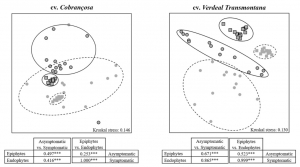
Diogo Mina, José Alberto Pereira, Teresa Lino-Neto, and Paula Baptista
Plant-inhabiting microorganisms interact directly with each other affecting disease progression. However, the role of host plant and plant habitat in shaping pathobiome composition and their implication for host susceptibility/resistance to a particular disease are currently unknown. For the elucidation of these questions, both epiphytic and endophytic bacterial communities, present in asymptomatic and symptomatic twigs from olive cultivars displaying different susceptibilities to olive knot (OK) disease, were investigated using culturing methods. OK disease was the main driver of the bacterial community, causing changes on their diversity, abundance and composition. OK disease effect was most notorious on OK-susceptible cultivar and when considering the endophytic communities. Plant habitat (epiphytes vs. endophytes) also contributed to the bacterial community assembling, in particular on symptomatic twigs (knots) of OK-susceptible cultivar. In contrast, host cultivar had little effect on the bacterial community composition, but OK-symptomatic twigs (knots) revealed to be more affected by this driver. Overall, the pathobiome seems to result from an intricate interaction between the pathogen, the resident bacteria, and the plant host. Specific bacterial genera were associated to the presence or absence of OK disease in each cultivar. Their ability to trigger and/or suppress disease should be studied in the future.
Doi: 10.1038/s41598-020-60596-0
Cited as: Mina D, Pereira JA, Lino-Neto T, et al. (2020) Impact of plant genotype and plant habitat in shaping bacterial pathobiome: a comparative study in olive tree. Science Reports 10, 3475; https://doi.org/10.1038/s41598-020-60596-0.



